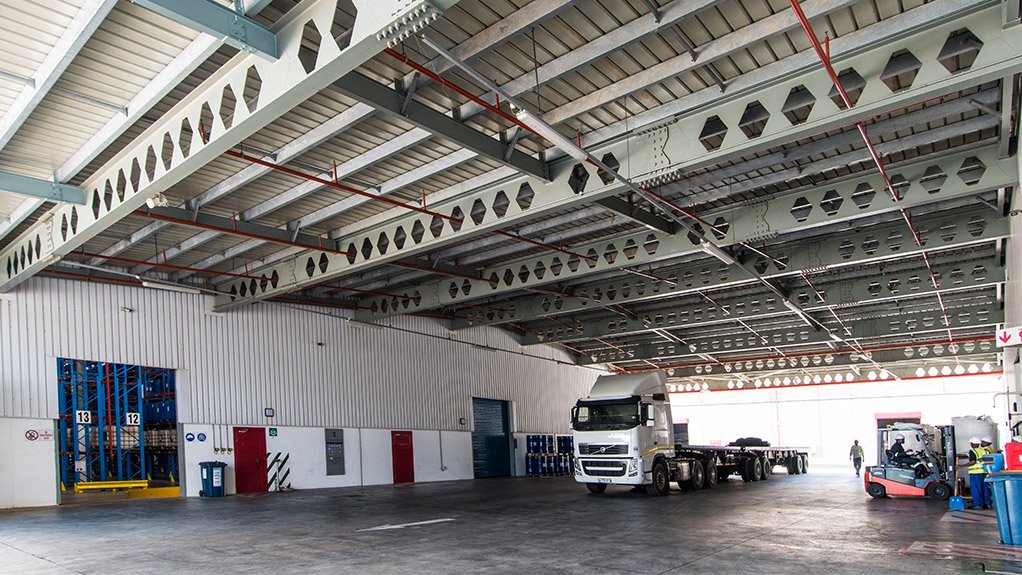
Arup was commended for their entry of the V&A Grain Silo Complex façade in the Architectural Category at the 2018 South African Steel Awards on 11 October 2018. The company, an independent firm of designers, planners, engineers, consultants and technical specialists, works across every aspect of the built environment, and has been recognised for its steel projects at previous Steel Awards. This year, the company had three project entries shortlisted for the finals – the other entries were the lobby of PwC Tower in Midrand, Gauteng in the commercial category and the Ashgate facility in Kwa-Zulu Natal in the factory and warehouses category.
V&A Grain Silo Complex Façade
A spectacular example of architectural adaptive reuse, the V&A Grain Silo, once an agricultural silo for grain storage, has quickly become one of Cape Town’s most desirable developments. The industrial heritage complex is now the jewel in the crown of the Silo District development, and the refurbished silo is occupied by The Zeitz Museum of Contemporary Art Africa (MOCAA) and The Silo Hotel.
The most noticeable and significant aspect of the use of steelwork on the project are the 98 pillow windows on the building. These are installed into the existing concrete frame, where existing masonry infill could be removed, at the rooms and restaurant of The Silo Hotel and on the top floor of the Zeitz MOCAA.
Other significant use of steelwork in the façade packages include:
- Zig-zag windows: folded glass windows built into the silo walls at the museum ground floor, supported by steel flat plate structure).
- Trafficable skylights: nine trafficable glass panels supported by steel structure to the top of the silos over the museum atrium.
- Skylight: glass skylight between the silo building and elevator building supported by steel structure.
Tessa Brunette, senior façade designer at Arup, says that Arup’s brief from Heatherwick Studio was to give new life to the redundant industrial building, repurposing it into something new for the V&A Waterfront. “Arup developed the concept of the pillowed windows following the studio’s suggestion of installing convex windows into the upper storeys of the building in order to transform it into a glowing beacon within the city bowl. Achieving the pillow window geometry was the most significant challenge. Working collaboratively with Heatherwick Studio, we created a parametric 3D model that established a series of geometrical and technical ‘rules’, within which the studio had full control of the geometrical resolution by defining the projection of each node and the main joint lines. This allowed the architects to drive the aesthetic resolution within an entirely technically feasible framework, and for the complex design to be achieved efficiently and act as a sound basis for procurement.
This parametric model was used to generate a 3D model of each of the five window frames, that included the required member size and orientation that was provided to Mazor, the steelwork fabricator, to produce their steelwork shop drawings. A close working relationship was required with the main contractor, WBHO, and the specialist façade contractor, Mazor, to fabricate and install these complex and unique façade modules.
PwC Tower – Triple Height Lobby
PwC’s new head office in Johannesburg has already become an iconic landmark, known for its 28-storey twisting tower. The steel award entry focuses on the triple volume lobby area at ground floor. It houses a reception that flows into the adjacent meeting centre and is used as a café and informal meeting space. It houses many components that feature the use of steelwork in a complex geometric form and often the painted steel is exposed to form the finished surface.
A steel and glass atrium roof covers the link between the tower and the meeting centre and a steel link bridge with glazed balustrades connects the two floors at first floor level with a steel feature stair forming the principal link up to the second floor of the meeting centre. Whilst most of the tower floors are post-tensioned concrete, the first and second floors of the tower are formed in steelwork with Bondek® slabs and are hung from the third floor, to increase the column-free space in the lobby below. The northern part of the lobby features a triple volume steel and glass façade, gently following the twist of the tower.
Within the atrium and outside the glass façade the sloping and spiralling columns of the building are encased in steel tubes to act compositely with the concrete inside. Arup structural engineers chose this solution to increase the capacity of the reinforced concrete columns to achieve a similar section size to the rest of the tower despite spanning unrestrained over three storeys.
Ashgate
The development includes three separate warehouse structures within the Umbogwintwini Industrial Complex in Kwa-Zulu Natal on a brown field site. The structures were required for storage and distribution of chemicals. The project contained 600,780 tonnes of steel.
Warehouse A is designed to store the flammable bulk chemicals in the facility and uses precast columns and tilt-up walls to the underside of the steel roof sheeting. The connection of the steelwork to the precast concrete elements required some unusual connection solutions for the purlins, which are chemically anchored to the top of the wall. The steel roof is non-continuous over the whole warehouse and is designed per compartment within the warehouse for safety. In the case of fire, it will help to prevent the spread of the fire or fumes or progressive collapse and to will limit the damage done in case of an explosion or fire.
Warehouses B and C have internal racking to store mainly non-flammable liquid chemicals in containers. Arup engineers had to ensure minimal horizonal deflection of the structure in one of the warehouses due to 13m high racking being placed next to the walls and the use of Very Narrow Aisle (VNAs) forklifts for the placing and removal of the containers. The two warehouses are connected by a steel canopy spanning over the road and loading area.